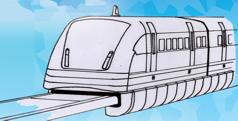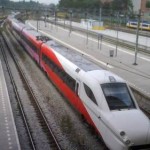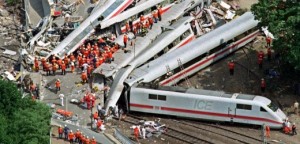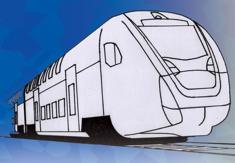Wich considerations we made in selecting a particular technology?
- The value for the traveller is key, not the technology itself.
- As traveler values we consider: convenience, safety, reliability, availability, accessibility, affordability, high frequency, panoramic view and short journey time
- The technology must have been tested and readily available for passenger transport.
- Plans should minimize inconvenience to local residents. Think of the routing, land use, water management, noise and visual pollution complaints.
- Added value in the long term is more important than short-term savings.
Transrapid Maglev for intercity service
Following the Japanese example, in our vision the intercity network will get its own entirely dedicated infrastructure, but still interconnects all existing intercity train stations. In order to offer the traveler improved travel times we wanted to increase the average speed. We looked at the regular train, high speed train and super speed Maglev (magnetic train) as used in China and under construction in Japan. It showed the latest generation of German super-speed Maglev Transrapid most suitable for the Dutch situation.
We are aware that there are many misunderstandings and conflicting statements about Maglevs. Unknown makes unloved, even goes for specialists in the train world. Thankfully, with the right expertise and Maglev contacts we were able to see trough.
In terms of noise, cost, economy, safety , etc. we found no argument that would make use of Maglevs impractical. On the contrary, Maglev offers the traveler decisive added value for which the current rail has no alternative.
The selected Maglev “Transrapid”:
- enables incrementing the average speed of the entire public transport.
- is much more reliable than conventional trains. Has for instance no overhead wire to break.
- can reduce the travel time between the train stations 2 to 5-fold.
- will connect city centres. This is because TBM-tunneling has become mature too.
- has such trip times that provinces can and must distinguish themselves again.
- allows for each province to compete, and that not everything is concentrated in the Randstad.
- strengthens aviation in the Netherlands by interconnecting all airports and their hinterland. This way Maglev saves jet fuel and extends the life of aircrafts.
- can carry aircraft containers
- can connect all regions, each with their own specialisms, very well with each other and the rest of the world.
- is wide body vehicle. So extra space for luggage, people, folding bikes, strollers, wheelchairs, etc.
- is independently accessible for wheelchair users and other people who have difficulty walking.
- is operationally flexible without much higher costs of infrastructure ; suitable for speeds of 100-500 kmh, frequency up to about 10 vehicles per hour in each direction, and freely arranged vehicle length and interior layout for 100 – about 1200 passengers, with or without lavatories
- makes less noise and hence less nuicesance to local residents.
- has gotten cheaper infrastructure over the course of time.
- enables that less space is needed for the entire infrastructure in the Netherlands.
In our vision the Maglev is not a competitor to the train, but the missing link to take the whole rail travel to a higher level. What the jet engine means to aviation, the Maglev can do for railways.
Moreover, in our vision Maglev- en conventional train call at the same intercity stations. So travelers have an immediate alternative in case of irregularities or maintenance of one or the other. Maglev and conventional rail thus mutually improve value.
Why no high-speed train?
 Despite Maglev replacing the intercity service, the performance of the Maglev is such that a high-speed train always loses. Even when Maglev calls at more stations.
Despite Maglev replacing the intercity service, the performance of the Maglev is such that a high-speed train always loses. Even when Maglev calls at more stations.
Even more important is safety. We find the ordinary train unsuitable for very high speeds. Because there is still no solution to prevent derailment of a high speed train in case of a single wheel or axle failure. With the two super speed Maglevs Transrapid and JR Maglev, a partial loss of the levitation/guidance function does not immediately lead to catastrophic accidents such as the Eschede ICE disaster of June 3rd, 1998.

One tries to mitigate this by (costly) early replacement of parts and more frequent inspections. It should be clear that this is not a sustainable alternative. Recall that the Eschede accident happened at “only” 200 kmh, then one may safely state that high speed should be the domain of super speed Maglev.
Other reasons:
- Maglevs like Transrapid have been designed as regular intercity trains. You can quickly get in and out. High-speed trains, however, focus more on the luxury segment.
- Transrapid vehicles have room to travel comfortably while maintaining individual comfort. One can socialize and/or work and bring along folding bike or other single-person vehicles.
- Transrapid has been designed to carry aircraft containers
- Maglev is less affected by weather conditions like snow , autumn leaves, frozen switches and other such inconveniences.
- Maglev track requires very little maintenance, even at very high utilisation. Japan chose Maglev partly because there every night a work force of around 3000 (!) members is dispatched for the inspection, maintenance and repair of a stretch of the conventional high speed rail lines.
- High-speed trains require up to 5m tall noise abatement walls to address the noise. Transrapid requires no or much lower noise barriers so that passengers (think of tourists!) can see the environment instead of noise abatement walls.
Rolling stock for the existing network – the InterRegioSprinter (IRS)
 Our selection for the conventional rail network is the Bombardier-Twindexx, as is being ordered for the Swiss rail roads. This double decker meets the standards we’ve set.
Our selection for the conventional rail network is the Bombardier-Twindexx, as is being ordered for the Swiss rail roads. This double decker meets the standards we’ve set.
We were looking for rolling stock with:
- level entry everywhere, for easy access.
- evenly spaced doors, for better flow on platforms.
- space to carry large numbers of single-person vehicles.
- little loss of time when reversing direction, in other words an EMU.
- enough comfort.
- option for installation of the European train control standard ERTMS/ETCS
Choice of catenary voltage
The trains are powered by electrical energy from the overhead wire. The combination of voltage and current determines the power that can be supplied to the trains.
The existing Dutch system of 1800 V line voltage can not supply enough current to run multiple trains in a high frequency schedule (especially during acceleration). A higher voltage would require less current to deliver the same power, and would hence solve the problem. The 1800 V is the upper limit of the system that was originally intended for 1500 V.
From a short-term savings standpoint, it has been proposed to double the voltage to 3000 V. However, we recommend using the standard of 25,000 V because:
- it is future proof (European standard, but also in use in Japan and China)
- many more trains can run simultaneously, compared to 3000 of 3600 V
- there simply is more (and therefore cheaper) equipment on the market now. No Fyra orders required.
- it already has been tested with ERTMS/ETCS.
- allows much cheaper energy feed back to the grid.
- other parts of our network (Betuweroute and HSL) already have been fitted with 25 kV and as such could be easily integrated with the rest of the network.
- we then no longer require the voltage transition locks. Resulting in less equipment failures, lighter trains with more space for passengers.
Reasons for selecting control system ETCS/ERTMS
The current network uses signals along the track and the ATB safety system. This system has some shortcomings and is in need of replacement. The capacity of ATB can not be extended without placing a large number of additional signals.
The European safety system ETCS/ERTMS does allow for high-frequency services and better track usage. It is also safer than ATB-vv, the enhanced version of ATB. Moreover, it is a European standard and in-cab signaling is cheaper than installing and changing thousands of signals.
So we prefer to introduce ETCS/ERTMS level 2 (and later 3). We support the proposal of engineer A.C.F. Sierts (Public Transport Analysis Design & Consultancy) to first only roll out the protection function of ETCS nationwide. According to Sierts, this can be completed within 5 years, as can be read in the article on SpoorPro.nl of May 15th, 2014.. In the following phase, the in-cab signalling function of ETCS level 2 can be rolled out.
